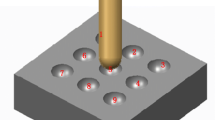Abstract
A new machining method for lens molds using tilt electrical discharge milling (ED milling) has been experimentally investigated. Compared with the conventional ED milling, the tilt ED milling enables efficient enlargement of discharge gap by adjusting the tilt angles of the workpiece which results in efficient chip removal and burnish surface quality. On account of this method, micro lens craters were fabricated on the tungsten carbide (WC) and silicon carbide particulate reinforced aluminum metal matrix composite (SiCp/Al) at the optimized machining parameters under various tilt angles of the workpiece. The surface morphology and material removal rate were determined with a laser scanning microscope VK-X100 (KEYENCE, Japan). Experimental results present a 60% rise in surface quality at 25° in tilt ED milling. On the basis of electromagnetic effect, the machining mechanism is analyzed in detail in tilt ED milling for lens molds.
Similar content being viewed by others
References
Zhou T, Yan J, Masuda J, Kuriyagawa T (2009) Investigation on the viscoelasticity of optical glass in ultraprecision lens molding process. J Mater Process Technol 209(9):4484–4489. https://doi.org/10.1016/j.jmatprotec.2008.10.030
Reynaerts D, Meeusen W, Van Brussel H (1998) Machining of three-dimensional microstructures in silicon by electro-discharge machining. Sensors Actuators A Phys 67(1):159–165. https://doi.org/10.1016/S0924-4247(97)01724-X
Peng Z, Wang Z, Dong Y, Chen H (2010) Development of a reversible machining method for fabrication of microstructures by using micro-EDM. J Mater Process Technol 210(1):129–136. https://doi.org/10.1016/j.jmatprotec.2009.08.002
Seo YW, Kim D, Ramulu M (2006) Electrical discharge machining of functionally graded 15–35 vol% SiCp/Al composites. Mater Manuf Process 21(5):479–487. https://doi.org/10.1080/10426910500471482
Hu FQ, Cao FY, Song BY, Hou PJ, Zhang Y, Chen K, Wei JQ (2013) Surface properties of SiCp/Al composite by powder-mixed EDM. Procedia CIRP 6:101–106. https://doi.org/10.1016/j.procir.2013.03.036
Dev A, Patel KM, Pandey PM, Aravindan S (2009) Machining characteristics and optimisation of process parameters in micro-EDM of SiCp/ Al composites. Int J Manuf Res 4(4):458–480. https://doi.org/10.1504/IJMR.2009.028541
Jahan MP, Wong YS, Rahman M (2009) A study on the fine-finish die-sinking micro-EDM of tungsten carbide using different electrode materials. J Mater Process Technol 209(8):3956–3967. https://doi.org/10.1016/j.jmatprotec.2008.09.015
Lee SH, Li XP (2003) Study of the surface integrity of the machined workpiece in the EDM of tungsten carbide. J Mater Process Technol 139(1):315–321. https://doi.org/10.1016/S0924-0136(03)00547-8
Sheu DY (2004) Micro-spherical probes machining by EDM. J Micromech Microeng 15(1):185
Wheeler HA (1942) Formulas for the skin effect. Proc IRE 30(9):412–424. https://doi.org/10.1109/JRPROC.1942.232015
Liu Q, Zhang Q, Zhu G, Wang K, Zhang J, Dong C (2016) Effect of electrode size on the performances of micro-EDM. Mater Manuf Process 31(4):391–396. https://doi.org/10.1080/10426914.2015.1059448
Schacht B, Kruth JP, Lauwers B, Vanherck P (2004) The skin-effect in ferromagnetic electrodes for wire-EDM. Int J Adv Manuf Technol 23(11–12):794–799. https://doi.org/10.1007/s00170-003-1654-6
Kiani K (2016) Column buckling of doubly parallel slender nanowires carrying electric current acted upon by a magnetic field. J Phys Chem Solids 95:89–97. https://doi.org/10.1016/j.jpcs.2016.03.013
Yong YW, Guo CN, Yang L (2015) Study on edm machining characteristics based on skin effect and magnetic field. Machinery Design and Manufacture. 0(2)4–7. https://doi.org/10.3969/j.issn.1001-3997.2015.02.002
Gong L, Wu JK (2007) Analysis on streaming potential and electro-viscous effect in a micro-diffuser, MEMS device and. Technology 44(6):312–318
Funding
This work has been financed by the National Key Basic Research Programme of China (No. 2015CB059900) and the National Natural Science Foundation of China (No. 51375050).
Author information
Authors and Affiliations
Corresponding author
Rights and permissions
About this article
Cite this article
Zhou, T., Zhou, C., Liang, Z. et al. Machining mechanism in tilt electrical discharge milling for lens mold. Int J Adv Manuf Technol 95, 2747–2755 (2018). https://doi.org/10.1007/s00170-017-1408-5
Received:
Accepted:
Published:
Issue Date:
DOI: https://doi.org/10.1007/s00170-017-1408-5



